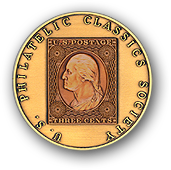This stamp is interesting for its postal history and uses in the mails of the period, its cancellations and postal markings, engraving characteristics called plating marks, and for the sheer beauty of the sophisticated engraving art of the time. While the 12¢ stamp has not been studied as much as the 1¢ and 3¢ stamps of the series, it is very rich in all these areas of potential study and collecting.

The postal Act of March 3, 1851, was to provide for relatively inexpensive postage and new graduated postal rates coupled with the issuance of a 1¢, 3¢, and 12¢ stamp. While only one plate (Plate One) was made for the 12¢ imperforate stamp in this series, there are a number of odd and interesting facts concerning the stamps and their uses. While official government records reveal that the denominations were distributed to many post offices on or about July 1, 1851, the earliest confirmed usage is August 4, 1851. Moreover, while the Post Office had delivered over 230,000 stamps by June 30, 1852, only 12 verified uses are documented for the entire last six months of 1851! This is in contrast to the 1¢ and 3¢ stamps, for which numerous first day of issue covers are known to exist as well as hundreds or thousands of covers from 1851. The number of dated uses for the stamps gradually increases in 1853 and beyond. Eventually, about 800,000 imperforate stamps were to be distributed.



While neither legally specified for this use, nor initially prohibited by law, the 12¢ stamp could also be and was used as a severed bisect or quadrisect in some form to pay logical fractions of the rates previously mentioned. If nothing else, there was precedent for this with the 1847 Ten Cent stamp, however rare.

Specialist’s estimate that less than 2000 covers exist today, although no census has been attempted. This number is in contrast to 13,000+ 1847 5¢ and 3300+ 1847 10¢ covers known to exist. Its primary use on legal envelopes and foreign mail probably explain the low retention numbers as these are less often saved over the years and more easily lost to history. Moreover, the novelty of the first postage stamps in 1847 might explain why larger numbers of those stamps were saved.
All 200 positions (2 panes of 10 rows by 10 columns of stamps on an engraving plate of 200 total impressions, divided by a centerline) were recut and strengthened to some degree because of less than desirable printing results. Most of the work was done on the inner and outer frame lines. However, the engraving rework was done with such extraordinary skill that only after some practice could students learn to detect much of the work. Overall, the work was phenomenal. Characteristic “position dots” on most of the stamps are key in identifying the majority of the 200 positions.

Even though the stamp is black, produced from carbon-based ink, a range of color differences is apparent. This was due to some changes in ink formulation, inking, and papers used over the period (initially, harder, thinner linen rag paper and later, softer, cotton rag based papers). The color differences can be quite dramatic.


Several complete right-hand panes and large multiples are known. However, practically none of the plating characteristics for each stamp position have been documented. Larger multiples from the left pane, even blocks of four, are rare and have made reconstruction difficult. Nevertheless, a few very odd things are known about this plate. Double, irregular vertical lines run from top to the bottom of the plate between rows 3 and 4. A similar, single line runs top to bottom between rows 7 and 8. No one knows the intended purposes of these lines. Multiple engraving and transfer errors, plate scratches, and odd recuts yet to be documented exist on these stamps. The challenge of plating the Plate 3 stamps continues.

Imperforates are documented from Plate 3, but no cancelled or used copies are known. Government correspondence indicates these were probably from a sample “half sheet” submitted for approval to the decision-makers. They were of higher quality than the finished stamps.
It was always believed that a single-relief transfer roll (the metal roller used to impress each of the 200 stamp entries on the master printing plate) was used to prepare the 12¢ plate. In 2000, it was discovered that two-relief roll was used to produce the plate. This was determined after careful study of many vertically adjoining “plated” stamps.
Plate One was known to have a plate inscription (called an “imprint”) on both the left and right sides of the plate identifying the engraver “Toppan, Carpenter, Casilear & Co., Bank Note Engravers, Phil., New York, Boston, & Cincinnati”. It was believed this inscription was on the Plate One from it inception. In 2001, a block of four stamps was discovered with large margins that, because of the stamps plated position, should have contained the inscription imprint. It did not, and, therefore it was then concluded that the Plate One existed in an “early state” without the imprint and a “late state” with the imprint. No one knows if other more subtle engraving changes were made at the same time as these changes were made.

The Swedish Tiger’s US Stamp Site Illustrated Guide
Siegel Encyclopedia (1857-60 Issue)
Civil War Timeline, at Siegel Encyclopedia

